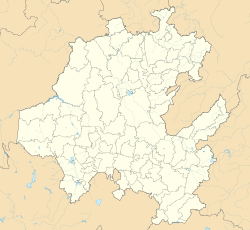Actopan | |
|---|---|
City | |
 | |
| Coordinates: 20°16′05″N 98°56′39″W / 20.26806°N 98.94417°W | |
| Country | Mexico |
| State | Hidalgo |
| Municipality | Actopan |
| Time zone | UTC-6 (Central) |
| Website | actopanhidalgo |
Actopan (from Nahuatl: Ātocpan 'thick, humid and fertile land') is a Mexican city, head of the municipality of Actopan in the state of Hidalgo.[1][2] Actopan is widely known for its gastronomy, especially for ximbo and barbacoa,[3] as well as for the Church and ex-convent of San Nicolás de Tolentino.[1][2]
The city is located north of Mexico City, from which it is 120 km away, and only 37 km from the city of Pachuca de Soto, the capital of the state of Hidalgo.[1][2] It is located within the geographical region known as Mezquital Valley.[4] According to the results of the 2020 Population and Housing Census of INEGI, the town has a population of 32,276 inhabitants,[5] which represents 52.91% of the municipal population.[6]
The city was a settlement of the Otomi people. In 1117 it was conquered by Chichimeca groups and became a dependency of Acolhuacan in 1120.[1][2] It was conquered by the Tepanecs of Azcapotzalco at the end of the 14th century.[7][8] The Mexica conquest took place in 1427 during the reign of Itzcoatl.[8] After the Conquest of Mexico, an encomienda was established in Actopan.[1][2] According to the Universal Dictionary of History and Geography, the city was founded on July 16, 1546;[9] although the date on which the anniversary of its founding is celebrated corresponds to July 8.[9] In 1575 Actopan was elevated to the category of village.[10]
It was elevated to Alcaldía Mayor in 1568; Actopan was the head and the towns around it were then República de Indios (Republic of Indigenous People).[11] Later it became Subdelegation in the period of the Bourbon Reforms;[12] and it acquired the character of City Hall and head of party, dependent on the district of Tula, on August 6, 1824.[13] On April 26, 1847, by decree of the Congress of the State of Mexico, Actopan was elevated to the category of town.[13][9][14]
On October 15, 1861, Actopan was declared a district of the State of Mexico.[13][14] On June 7, 1862, it became part of the military canton number 3 of the Second Military District of the State of Mexico, created to confront the French intervention in Mexico.[13][15] At the beginning, Actopan was temporarily the capital of the district, but it was changed to Pachuca.[16] During the Second Mexican Empire, Actopan became part of the department of Tula.[16] In 1869, the decree of establishment of the state of Hidalgo confirmed the character of District head of the new entity.[16]
The Constitution of Hidalgo of 1870 recognized Actopan as the 1st district, category that would be confirmed in the 1st article of the electoral laws of 1880 and 1894.[17] In the 3rd article of the Constitution of Hidalgo of 1 October 1920 it appears in the list as municipal seat, and in it is included as municipal seat of the municipality number 3 of Hidalgo.[17] When commemorating the fourth centennial of the foundation of Actopan, on July 8, 1946, the XXXVIII Legislature of the Congress of the state of Hidalgo, gave it the category of city.[18]
- ^ a b c d e Instituto Nacional para el Federalismo y el Desarrollo Municipal. "Enciclopedia de los Municipios y Delegaciones de México: Actopan, Hidalgo". Secretariat of the Interior (in Spanish). Government of Mexico. Archived from the original on December 8, 2017. Retrieved March 22, 2017.
- ^ a b c d e Sistema Integral de Información del Estado de Hidalgo. "Enciclopedia de los municipios de Hidalgo: Actopan" (PDF). Secretaría de Planeación Desarrollo Regional y Metropolitano (in Spanish). Gobierno del estado de Hidalgo. Archived from the original (PDF) on November 8, 2017. Retrieved March 22, 2017.
- ^ "Gastronomía". Gobierno del estado de Hidalgo (in Spanish). Archived from the original on December 10, 2016. Retrieved January 12, 2015.
- ^ Instituto Nacional para el Federalismo y el Desarrollo Municipal. "Enciclopedia de Los Municipios y Delegaciones de México: Regionalización del estado de Hidalgo". Secretariat of the Interior (in Spanish). Government of Mexico. Archived from the original on January 18, 2017. Retrieved March 22, 2017.
- ^ Catálogo Localidades – Microrregiones. "Localidad de Actopan, Hidalgo". Secretariat of Welfare (in Spanish). Government of Mexico. Archived from the original on July 27, 2020. Retrieved March 22, 2017.
- ^ Cédulas de Información Municipal. "Actopan, Hidalgo". Secretariat of Welfare (in Spanish). Government of Mexico. Archived from the original on July 30, 2017. Retrieved March 22, 2017.
- ^ Moreno Vidal, Fabiola (2016). "Análisis estilístico e iconográfico de la portada del templo de San Nicolás Tolentino en Actopan, Hidalgo". Boletín de Monumentos Históricos (in Spanish) (37). Mexico: Instituto Nacional de Antropología e Historia: 47–61. ISSN 0188-4638. Archived from the original on January 20, 2023. Retrieved February 9, 2023.
- ^ a b Vergara Hernández (2008, p. 15)
- ^ a b c Jiménez Ricárdez (2010, p. 7)
- ^ Manzano Campero (2009a, p. 14)
- ^ Vergara Hernández (2008, p. 55)
- ^ Menes Llaguno (2007, p. 15)
- ^ a b c d Instituto Nacional para el Federalismo y el Desarrollo Municipal. "Enciclopedia de los Municipios y Delegaciones de México: Gobierno del estado de Hidalgo". Secretariat of the Interior (in Spanish). Government of Mexico. Archived from the original on March 21, 2018. Retrieved March 22, 2017.
- ^ a b Menes Llaguno (2007, p. 17)
- ^ Menes Llaguno (2007, p. 18)
- ^ a b c Menes Llaguno (2007, p. 19)
- ^ a b Menes Llaguno (2007, p. 20)
- ^ Jiménez Ricárdez (2010, p. 8)

